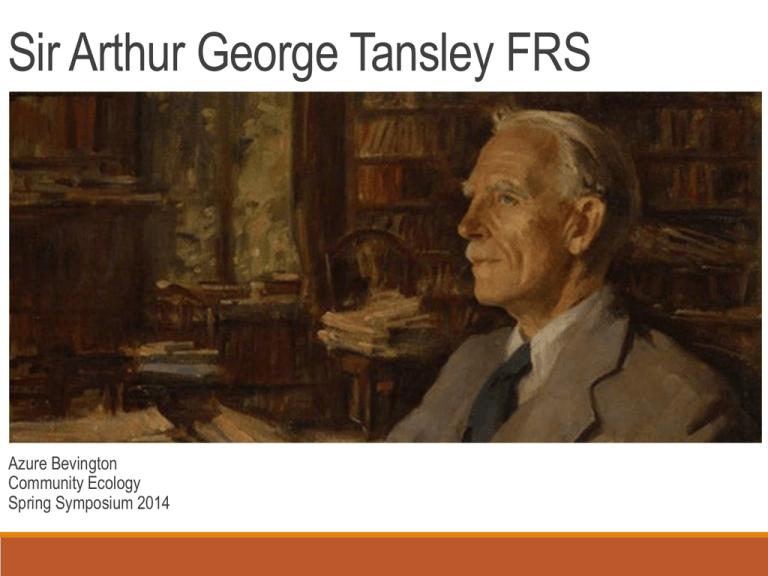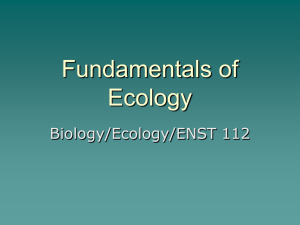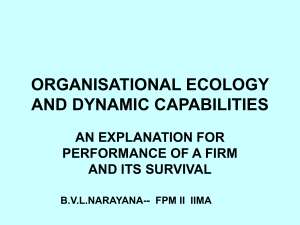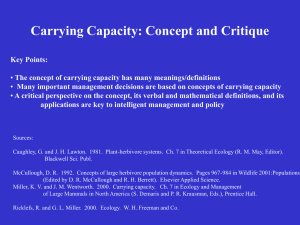Sir Arthur G. Tansley
advertisement

Sir Arthur George Tansley FRS Azure Bevington Community Ecology Spring Symposium 2014 Biographical sketch Born August 15, 1871 in London, UK Attended University College in London (1889) then transferred to Trinity College Cambridge (1890-1894) Taught at Univ. College (1893-1907) assistant to Prof FW Oliver FRS First introduced to ecology by Eugen Warmings book Plantesamfund in 1898 Travelled Sri Lanka, the Malay Peninsula and Egypt on botanical expeditions (1900-01) Founded the New Phytologist (1902) served as editor until 1931 Formed the Central Committee for the study of British Vegetation (1904) Taught at Trinity College Cambridge (1907-1923) Organized the first International Phytogeographic Excursion (1911) met American ecologists Cowles and Clements Founded the British Ecological Society (1913) Elected Fellow of the Royal Society (1915) Founded Journal of Ecology (1917) served as editor until 1937 Left Cambridge to study with Sigmund Freud in Vienna for a year 1923 Published scholarly articles and a book on psychoanalysis Elected to full membership of the British Psychoanalytic Society 1925 Returned to Ecology, as Sherardian Chair of Botany at University of Oxford in 1927 until retirement in 1937 Focused on synthesis and promoting conservation and the value of science to society Awarded Gold Medal of the Linnean Society (1941) President of the Council for the Promotion of Field Studies (1947-1953) Chairman of the new Nature Conservancy (later the Natural Environment Research Council) (1949) Knighted (1950) Died November 25, 1955 in Grantchester, UK Publications (peer reviewed and books) Tansley AG. 1883. On the Cleveland District. Westbury House School Ephemeris 19, 69-70. Tansley AG. 1896. The Stelar theory – a history and a criticism. Science Progress 5, 133-150. Tansley AG. 1896. The Stelar theory – a history and a criticism. II. The metamorphosis of the stele. Science Progress 5, 215-226. Tansley AG, Chick E. 1901. Notes on the conducting tissue-system in Bryophyta. Annals of Botany 15, 1-38. Blackman FF, Tansley AG. 1902. A revision of the classification of the Green Algae. New Phytologist 1, 17-24. Tansley AG. 1902. Ecological notes. New Phytologist 1, 84-5. Tansley AG, Lulham RB. 1902. On a new type of fern-stele, and its probable phylogenetic relations. Annals of Botany 16, 157-164. Chick E, Tansley AG. 1903. On the structure of Schizaea malacanna. Annals of Botany 17, 493-510. Tansley AG, Lulham RB. 1904. The vascular system of the rhizome and leaf-trace of Pteris aquilina L., and Pteris incisa, Thunb., var. integrifolia Beddome. New Phytologist 3, 1-17. Tansley AG, Thomas EM. 1904. Root structure in the central cylinder of the hypocotyl. New Phytologist 3, 104-106. Tansley AG. 1904. The problems of ecology: research in British ecology. New Phytologist 3, 191–200. Oliver FG, Tansley AG. 1904. Methods of surveying vegetation on a large scale. New Phytologist 3, 228-237. Tansley AG, Fritsch FE. 1905. Sketches of vegetation at home and abroad: The flora of the Ceylon littoral. New Phytologist 4, 1-17, 27-55. Tansley AG. 1905. Ecological expedition to the Bouche d’Erquy 1905. New Phytologist 4, 192-194. Blackman FF, Tansley AG. 1905. Ecology in its Physiological and Phytotopographical Aspects (Clements’ ‘Research Methods in Ecology’). New Phytologist 4, 199-203, 232-253. Tansley AG, Lulham RBJ. 1905. A study of the vascular system of Matonia pectinata. Annals of Botany 19, 475-476. Tansley AG. 1906. Some general aspects of the algae. A review of Morphologie und Biologie der Algen by Friedrich Oltmans. New Phytologist 5, 34-46. Tansley AG. 1907-8. Lectures on the evolution of the filicinean vascular system. New Phytologist 6, 25-35, 53-68, 109-120, 135-147, 148-155, 187-203, 219-238, 253-269; 7, 1-16, 29-40. Moss CE, Rankin WM, Tansley AG. 1910. The woodlands of England. New Phytologist 9, 125, 130-131, 147. Tansley AG. 1911. The International Phytogeographical Excursion in the British Isles. New Phytologist 10, 271–291. Tansley AG. 1911. Types of British Vegetation. Cambridge: Cambridge University Press, 1911. Tansley AG. 1912. The forest of Provence. Gardeners Chronicle 51, 89-90, 112-113, 131. Tansley AG. 1913. A universal classification of plant communities. Journal of Ecology 1, 27-42. Tansley AG. 1913. Primary survey of the Peak District of Derbyshire. Journal of Ecology 1, 275-285. Tansley AG. 1913-1914. The International Phytogeographic Excursion in America in 1913. New Phytologist 12, 322-336 and 13, 325333. Tansley AG. 1913. In: Hampstead Heath: Its Geology and Natural History. London: T Fisher Unwin, 87-92. Thompson HS. 1914. Flowering plants of the Riviera: a descriptive account of 1800 of the more interesting species; with an introduction on Riviera vegetation by AG Tansley. London: Longmans. Tansley AG. 1916. The development of vegetation. Journal of Ecology 4, 198-204. Blackman FF, Blackman VH, Keeble F, Oliver FW, Tansley AG. 1917. The reconstruction of elementary botanical teaching. New Phytologist 16, 241–252. Tansley AG. 1917. On competition between Galium saxatile L. (C. hercynicum Weig.) and Galium sylvestre Poll (G. asperum Schreb.) on different types of soil. Journal of Ecology 5, 173-179. Tansley AG. 1920. The New Psychology and Its Relation to Life. London: Allen and Unwin. Tansley AG.1920. The classification of vegetation and the concept of development. Journal of Ecology 8, 118–149. Salisbury EJ, Tansley AG. 1921. The Durmast oak-woods (Querceta Sessili-Florae) of the Silurian and Malvernian strata near Malvern. Journal of Ecology 9, 19-38. Tansley AG. 1922. Elements of Plant Biology. London: Allen and Unwin. Tansley AG. 1922. Studies of the Vegetation of the English Chalk: II. Early Stages of Redevelopment of Woody Vegetation on Chalk Grassland. Journal of Ecology 10, 168-177. Tansley AG. 1922. The new Zurich-Montpellier school. Journal of Ecology 10, 241-248. Tansley AG. 1922. The relations of complex and sentiment symposium. British Journal of Psychology 13, 113–122. Tansley AG. 1923. Practical Plant Ecology: A Guide for Beginners in Field Study of Plant Communities. London: Allen and Unwin. [revised and enlarged as Introduction to Plant Ecology 1946; extended by A.J.Willis, 1973] Tansley AG. 1924. The unification of pure botany. Nature 113, 85-8. Flahault C, Juel O, Schröter C, Tansley AG. 1924. Eug. Warming: in memorium. Botanisk Tidsskrift 39, 45-56. Tansley AG. 1924. Some aspects of the present position of botany. In: Report of the 91st meeting of the British Association, Liverpool, 1923. London: John Murray, 240-260. Tansley AG. 1925. Experiment in genetics (review of CC Hurst’s book with the same title). The Nation and the Athenaeum, (3 Oct), 1920. Tansley AG. 1925. Summary of vegetational work and problems in the Dominions. In: Brooks FT, ed. Imperial Botanical Conference 1924. Cambridge: Cambridge University Press, 259-269. Tansley AG. 1925. The vegetation of the southern English chalk (Obere Kreide-Formation). Festschrift Carl Schröter. Verüffentlichungen des Geobotanischen Institutes Rübel in Zürich 3, 406-430.. Tansley AG, Adamson RS. 1925. Studies of the Vegetation of the English Chalk: III The chalk grasslands of the Hampshire-Sussex border. Journal of Ecology 13, 177- 223. Tansley AG, Adamson RS. 1926. Studies of the Vegetation of the English Chalk: IV A preliminary survey of the chalk grasslands of the Sussex Downs. Journal of Ecology 14, 1-32. Tansley AG, Chipp TF. 1926. Aims and Methods in the Study of Vegetation. London: Whitefriars Press. [edited for and published by the British Empire Vegetation Committee and Crown Agents for the Colonies. Tansley and Chipp wrote most of Part I, Nature and Aims of the Study of Vegetation; Plant Communities; Factors of the Habitat; Training; Methods of Investigation; and Collecting]. Tansley AG. 1927. Review of C.J. Patten: The Memory Factor in Biology. International Journal of Psychoanalysis 8, 292. Tansley AG. 1927. Abstract of F.Teller: Libidotheorie und Artumwandlung. International Journal of Psychoanalysis 8, 531. Tansley AG. 1927. The Future Development and Functions of the Oxford Department of Botany. Oxford: Clarendon Press. Tansley AG. 1929. Succession: the concept and its values. Proceedings of the International Congress of Plant Sciences, Ithaca. 1, 677. Manasha, Wis.: Banta. Godwin H, Tansley AG. 1929. The Vegetation of Wicken Fen. In The Natural History of Wicken Fen, Part V, edited by Stanley Gardiner. Cambridge: Bowes & Bowes. Tansley AG, Watt AS. 1932. British beechwoods. Die Buchenwälder Europas, Verüffentlichungen des Geobotanischen Institutes Rübel in Zürich 3, 294-361. Tansley AG. 1935. The use and abuse of vegetational concepts and terms. Ecology 16, 284–307. Tansley AG. 1939. British ecology during the past quarter-century: The plant community and the ecosystem. Journal of Ecology 27, 513–530. Tansley AG. 1939. The British Islands and their Vegetation. Cambridge: Cambridge University Press. Tansley AG. 1940. Natural and semi-natural British woodlands. Forestry 14, 1-21. Tansley AG. 1942. The values of science to humanity. Nature 150, 104-110 [text of the Herbert Spencer Lecture] Godwin H, Tansley AG. 1942. The Vegetation of Wicken Fen. Tansley AG. 1943. Nature reserves. The Spectator, 519-520. Tansley AG. 1945. Our Heritage of Wild Nature: A Plea for Organized Nature Conservation. Cambridge: Cambridge University Tansley AG. 1946. Introduction to Plant Ecology. London: Allen and Unwin. [Revision of Practical Plant Ecology 1923] Tansley AG. 1946. Discussion of fundamental research in relation to the community. Advancement of Science 3, 294-295. Baker JR, Tansley AG. 1946. The course of the controversy on freedom in science. Nature 158, 574–576. Tansley AG, Price Evans E. 1946. Plant Ecology and the School. London: Allen & Unwin. Tansley AG. 1947. The early history of modern plant ecology in Britain. Journal of Ecology 35, 130–137. Tansley AG. 1949. Britain’s Green Mantle: Past, Present, and Future. London: Allen and Unwin. [revised by M.C.F.Proctor, 1968] Tansley AG. 1951. What is Ecology? Council for the Promotion of Field Studies. [reprinted (1987) in the Biological Journal of the Linnean Society] Tansley AG. 1952. Oaks and Oak Woods. London: Methuen. Tansley AG. 1952. Mind and Life: An Essay in Simplification. London: Allen and Unwin. Tansley AG. 1952. The psychological connexion of two basic principles of the SFS. Society for Freedom in Science, Occasional Pamphlet no.12. Tansley AG. 1954. Some reminiscences. Vegetation 5-6, vii-viii. From botanist to ecologist Early work focused on bryophytes and plant physiology Also descriptive surveys of coastal vegetation in Britain In 1898 he read Eugen Warming’s Plantesamfund The founder of ecology English translation and the origin of the word ecology: Oecology of Plants: An Introduction to the Study of Plant Communities, by Eugen Warming and Martin Vahl (1909) “The German translation was widely read in England and America and played an important part in stimulating fieldwork in both, countries. It certainly did in my own case: I well remember working through it with enthusiasm in 1898 and going out into the field to see how far one could match the plant communities Warming had described for Denmark in the English countryside.” - from The Early History of Modern Plant Ecology in Britain, 1947 http://en.wikipedia.org/wiki/Eugenius_Warming Contributions to ecology Establishing connections The New Phytologist, 1902 British Ecological Society, 1913 Journal Ecology, 1917 Foundation and structure The problems of ecology: research in British ecology. 1904 The reconstruction of elementary botanical teaching. 1917 Methods Practical Plant Ecology: A Guide for Beginners in Field Study of Plant Communities. 1923 Aims and Methods in the Study of Vegetation. 1926 Introduction to Plant Ecology. 1946 [Revision of Practical Plant Ecology 1923] Synthesis The use and abuse of vegetational concepts and terms. 1935 The British Islands and their Vegetation. 1939 Conservation Our Heritage of Wild Nature: A Plea for Organized Nature Conservation. 1945 Britain’s Green Mantle: Past, Present, and Future. 1949. Establishing connections The New Phytologist (established 1902) Was begun to provide a means to communicate with other young botanists “a medium of easy communication and discussion… on all matters…including methods of teaching and research.” Publication was rapid, to allow for inclusion of new observations as well as short notices of important new books and papers were to be a regular feature, as were short reports of meetings of botanical and biological interest Tansley Review A selected article with a broad over view included in all issues “…the perfect starting point to get an authoritative overview of a topic and they are written in a way to be reasonably accessible to a non-specialist” -from New Phytologist facebook page Tansley Medal Awarded annually in recognition of an outstanding contribution to research in plant science by an individual in the early stages of their career http://www.newphytologist.org/app/webroot/img/upload/images/tansley/npfirstissuelg.jpg http://onlinelibrary.wiley.com/journal/10.1111/(ISSN)1469-8137/homepage/cover_gallery_2014.htm#2014 Establishing connections British Ecological Society Established in 1913 Currently has ~4,000 members worldwide Membership is open to all with an interest in ecology Journal of Ecology Established in 1917 Served as editor until 1937 Aims and scope: All aspects of the ecology of plants (including algae), in both aquatic and terrestrial ecosystems Foundation and structure The problems of ecology: research in British ecology. 1904 The need for rigor and structure in order for ecology to be taken seriously “Ecology may now be considered almost a fashionable study, but there are not wanting botanists who tacitly distrust, even if they do not openly condemn, a good deal of the work done under its name.” “…it appears useful to consider the subject from a general point of view in the hope of pointing out some of its dangers and clearing up some of the misapprehensions.” What is Ecology? Starts by limiting the definition somewhat, to include primarily the “..topographical aspects of these relations, …which depend directly upon differences of habitat among plants.” Topographical physiology of plants, or plant-geography on a physiological basis Influenced by Warming’s book “ “…that may truly be described by the often abused term epoch-making.” Acknowledges that this is likely too limiting, but that this is at least a part of ecology as a whole and where his interests and knowledge lie Foundation and structure Lays out the 2 aspects of the development any scientific discipline I. The descriptive stage, ecological survey “…characterized, enumerated and described” Individual species as well as association, topography, geology, climate This must be done before most mechanism can even be hypothesized, let alone tested This work is being undertaken to a large degree Would like to add rigor and efficiency Develop a coordinated effort and criteria for vegetation mapping Utilize the local knowledge of botanical field clubs II. The experimental stage “… the second and highest goal of scientific curiosity is to unravel the causes of phenomena, to go beyond the intuition of the gross appearances of what we see around us, to enquire as to their causation… to attempt the determination of the simple invariable time-sequences that exist in nature.” This is more difficult and had yet to be undertaken “…involves careful and patient observation and experiment, and the application and adaptation of the methods of ordinary physiology.” These can be done hand in hand Establishment of research labs in regions of specialized vegetation Desert Laboratory of the Carnegie Institute, established near Tucson, AZ in 1903 Foundation and structure The reconstruction of elementary botanical teaching. 1917 Laid forth a claim that the teaching of botany, particularly at the elementary university level was too dominated by botanical morphology Determination of structure in order to trace the phylogentic relationships “…ought not to be made the main topic…because, in its current form, it is sterile and leads to little but further refinements of itself, and because it has no outlets on practical life. ...something broader, more vital and more practical” Called for the inclusion of instruction of plant physiology and evolutionary ecology Were being pushed out of the field, why not let this happen? “… would be bad for the subject and bad in various degrees for everyone concerned.” Similar to the separation of animal physiology from zoology, leaving traditional zoology a stagnating field Would result in physiologists with no connection or broad understanding of the living plant and its environment Would revitalize the entire field as a whole and attract new students who would not otherwise seek a career in botany “… poor remuneration available to any save a few botanists and to the paucity of reasonably paid research posts… limited outlets on practical life which botany at present affords.” Foundation and structure Lays out an outline of the natural development of elementary teaching (first two “…with broad outlets on practical life.”) I. General plant physiology and ecology Agriculture and land utilization II. Specialized biochemistry and biophysics of plants Application to questions of physic-chemical reactions of plants and plant substances in agriculture and industry III. Advanced morphology, systematic botany At all levels there is also opportunity for both theoretical and applied research Incorporation of practical application is an extremely important consideration Prevents “academicism, whose characteristic vices are formalism, pedantry and hair splitting.” Foundation and structure Reaction to the “Tansley Manifesto” Provided an outline of prosed revisions for elementary and honours courses at University New Phytologist provided an avenue and invited comment on the memorandum Over the next year much discussion was included from many in the field Much of the response was in agreement with the authors, at least to varying degrees It was stated that they went to far in requesting “subordination of morphology” Some suggested and formed a committee that would provide guidelines for revision of botany courses Others very much disagreed, including many of the leading botanist of the time Labelled as “Botanical Bolsheviks” (Bower and Balfour) Tansley passed over for the Sherardian Chair of Botany at Oxford appointment in 1919 Along with other factors, it led to a period of disillusionment and turmoil Led him to psychoanalysis and eventual study with Freud in Vienna in 1923 Methods Defining the methodology of a new discipline Practical Plant Ecology: A Guide for Beginners in Field Study of Plant Communities. 1923 A text book aimed at students in ecology I. Introductory, What is Ecology? II. Structure Distribution and Development of Vegetation III. Methods of Studying Vegetation IV. The Habitat V. Ecological Work in Schools “This chapter and the next contain specific suggestions to teachers – put forward with the diffidence due from one who has no first-hand experience of school teaching – as to the ways which ecology can be used in schools.” Aims and Methods in the Study of Vegetation. 1926 A research methods book designed to bring together accounts of the methods of a number of researchers He acknowledges that he is only trying to provide a starting point and encourages field ecologists to build up on the work Introduction to Plant Ecology. 1946 Updated expansion and revision of Practical Plant Ecology 1923 Synthesis The use and abuse of vegetational concepts and terms. 1935 “... I shall take the opportunity of trying to clarify some of the logical foundations of modern vegetational theory” Trying to build on (Clements) and refute (Phillips) previous work Succession Ecosystem Synthesis: Succession (many definitions) Cooper (1926) says that succession is any change in vegetation that occurs and is a continuous forward progression Tansley: only succession if there is a recognizable series of phases with a direction Disturbance/interruption can reset succession to an earlier stage Clements Directional development to a single climax community Considers community a complex-organism Tansley: disagrees with the strict limits on climax communities as well as the excessive nomenclature of Clements successional seres Tansley’s definition Establishes autogenic and allogenic succession (Intl. Congress of Plant Science 1926) “… actual successions commonly show a mixture of these two classes of factors – the external and the internal.” In 1935 he states that he “… should have applied [his] suggested new terms to the factors rather than the successions.” “… actual successions commonly show a mixture of these two classes of factors – the external and the internal Synthesis: Ecosystem Use of super-organism or complex-organism for the community or biome as had been established by Clements and others was objectionable to Tansley The biome or community was not an organism, and was not analogous to one The term super- or complex-organism already has a use outside of ecology “The fundamental concept appropriate to the biome considered together with all the effective inorganic factors of its environment is the ecosystem, which is a particular category among the physical systems that make up the universe.” “It is the systems so formed which, from the point of view of the ecologist, are the basic units of nature on the face of the earth.” Was the first scholarly use of this term Arthur Roy Clapham FRS actually coined it as a student at Tansley’s request Synthesis: Ecosystem concept through time 1935 Tansley’s ecosystem encompassing all biotic and physical factors 1942 Lindeman, establishes trophic dynamics and energy transfer within the ecosystem “ The ecosystem may be formally defined as the system composed of physical-chemical-biological processes active within a space-time unit of any magnitude” 1953 E.P. Odum, the ecosystem to be the basic fundamental unit of ecology Other words have been proposed (Willis 1997) but didn’t stick Microcosm, biosystema, holocoen, epigen, ecotope , and bioecos Has led to development of ecosystem ecology, modeling, experimental manipulations Still much support as well as contention over the concept and definition Ecosystem concept topped of the list of survey of the most important concepts in ecology (BES 75th anniversary 1987) Synthesis The British Islands and their Vegetation. 1939 This is his seminal work of the plant ecology of Great Britain Exhaustive synthesis of current ecological research and knowledge (930p) Includes sections on the geology, climate, and soil properties Also ecological interctions http://www.newphytologist.org/sections/index/8 Conservation Conservation and protections of natural areas was the focus of his work after retirement Our Heritage of Wild Nature: A Plea for Organized Nature Conservation. 1945 Written following WWII, to try to include conservation in Britain’s reconstruction Britain’s Green Mantle: Past, Present, and Future. 1949. Was a take off of a book by Sydney Mangham, published in 1939 Intended as a field guide to Great Britain's vegetation and distinct communities Establishes the importance of geology, climate, soil conditions on vegetation “The present book is intended for all who want to know more about our native vegetation, what it consists of, and how it cam to be what it is, but have no time or inclination for specialized study… I have included only so much of the material in my larger work as I thought might be of interest to all who love our wilder countrysides; but the aim has been to furnish a good deal of solid information” He was knighted based on his contributions to the protection and preservation of GB’s lands http://www.newphytologist.org/sections/index/8 Commemoration Plaque at Kingley Vale National Nature Reserve, Chinchester He considered it the finest view in Great Britain Was one of the first reserves he established when he was chairman of the Nature Conservancy http://s0.geograph.org.uk/geophotos/01/50/35/1503536_f25f725b.jpg References Blackman FF., Blackman VH., Keeble F., Oliver FW., Tansley AG. 1917. The reconstruction of elementary botanical teaching. New Phytologist 16, 241–252. Currie, WS. 2010. Units of nature or processes across scales? The ecosystem concept at age 75. New phytologist 190: 21-34. Lindeman, R.L. 1942.The trophic-dynamic aspect of ecology. Ecology 23:399-417. Odum, EP, Odum H.T.1953. Fundamentals of ecology. Philadelphia: Saunders. Tansley AG. 1904. The problems of ecology: research in British ecology. New Phytologist 3:191–200 Tansley AG. 1920. The classification of vegetation and the concept of development. Journal of Ecology 8:118–149. Tansley AG. 1923. Practical Plant Ecology: A Guide for Beginners in Field Study of Plant Communities. London: Allen and Unwin. [ Tansley AG. 1924. The unification of pure botany. Nature 113, 85-8.Tansley AG, Chipp TF. 1926. Aims and Methods in the Study of Vegetation. London: Whitefriars Press. Tansley AG. 1929. Succession: the concept and its values. Proceedings of the International Congress of Plant Sciences, Ithaca. 1:677. Tansley AG. 1935. The use and abuse of vegetational concepts and terms. Ecology 16:284–307. Tansley AG. 1939. British ecology during the past quarter-century: The plant community and the ecosystem. Journal of Ecology 27:513–530. Tansley AG. 1939. The British Islands and their Vegetation. Cambridge: Cambridge University Press. Tansley AG. 1945. Our Heritage of Wild Nature: A Plea for Organized Nature Conservation. Cambridge: Cambridge University Tansley AG. 1946. Introduction to Plant Ecology. London: Allen and Unwin. Tansley AG. 1949. Britain’s Green Mantle: Past, Present, and Future. London: Allen and Unwin. Willis, AJ. 1997. Forum. Functional Ecology 11:268-271. template Quasi organism Clements supported holism Considered vegetational communities to develop analogous to an organism Referring to them as super organisms








